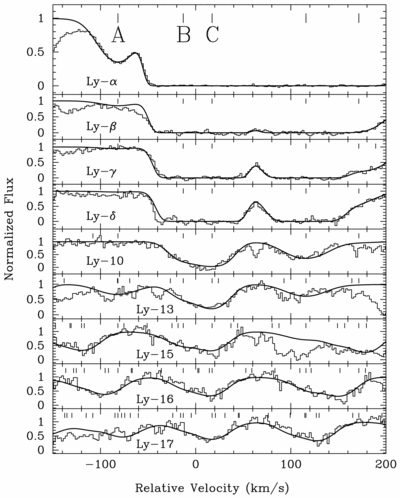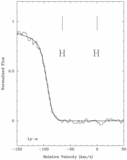Image Details

Caption: Fig. 1.
Lyman lines of the ﹩z_{\mathrm{abs}\,}=3.32﹩ system. The tick marks correspond to the line centers of individual components used in the model fits. Line A is the candidate for D absorption. Components B and C contain the majority of H I in this system, and the best‐fit parameters for each component are (B) ﹩v=-13\pm 3﹩ km s﹩^{-1}﹩, ﹩\mathrm{log}\,N﹩(H I﹩) =16.12\pm 0.12﹩ cm﹩^{-2}﹩, and ﹩b=17\pm 2﹩ km s﹩^{-1}﹩; (C) ﹩v=17\pm 1﹩ km s﹩^{-1}﹩, ﹩\mathrm{log}\,N﹩(H I﹩) =16.61\pm 0.05﹩ cm﹩^{-2}﹩, and ﹩b=19\pm 1﹩ km s﹩^{-1}﹩. The S/N in each panel is 55, 20, 17, 13, and 10 per 2 km s﹩^{-1}﹩ pixel for Lyα, Lyβ, Lyγ, Lyδ, and Ly‐10 and above, respectively. For Ly‐10–17 we see absorption from more than one series line in each panel, e.g., velocity −40 km s﹩^{-1}﹩ in Ly‐16 is also +66 km s﹩^{-1}﹩ in Ly‐17. Each tick marks the position of a hydrogen Lyman line. In the higher order lines, the components of the Lyman series begin to overlap and the model profile becomes more complicated.
Copyright and Terms & Conditions
© 1999. The American Astronomical Society. All rights reserved. Printed in U.S.A.




